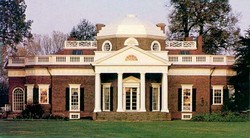Thomas Jefferson Virginia
|
| updated |
Copy Link Code
|
 Besides the White House, only one home has become so ubiquitous in America by a depiction that has been printed millions of times over. Thomas Jefferson's Monticello, the neoclassic mansion shown on the reverse of a nickel, is meant to represent an ideal of American Enlightenment through the architecture of a Founding Father and notable polymath. Unfortunately, Monticello, home of Thomas Jefferson, was not only a mansion but also a large plantation housing hundreds of African American slaves. Like many of America's most iconic buildings including the Capitol building and the White House, most of the laborers who built Monticello were African Americans in bondage. The real story of Thomas Jefferson and Monticello is deeply revealing about the contradictions and hypocrisy of a man who demanded liberty for those like him but denied it to those who toiled to provide him with wealth and fortune. Thomas Jefferson's house, much like the man himself, holds a legacy that is a lot more idealistic than the reality of its existence.
Besides the White House, only one home has become so ubiquitous in America by a depiction that has been printed millions of times over. Thomas Jefferson's Monticello, the neoclassic mansion shown on the reverse of a nickel, is meant to represent an ideal of American Enlightenment through the architecture of a Founding Father and notable polymath. Unfortunately, Monticello, home of Thomas Jefferson, was not only a mansion but also a large plantation housing hundreds of African American slaves. Like many of America's most iconic buildings including the Capitol building and the White House, most of the laborers who built Monticello were African Americans in bondage. The real story of Thomas Jefferson and Monticello is deeply revealing about the contradictions and hypocrisy of a man who demanded liberty for those like him but denied it to those who toiled to provide him with wealth and fortune. Thomas Jefferson's house, much like the man himself, holds a legacy that is a lot more idealistic than the reality of its existence.
Located in the northern part of Virginia, home state of Thomas Jefferson, and close to the Thomas Jefferson hometown of Shadwell, construction of Monticello began in 1768 with the leveling of a mountain top to accommodate the main building. Where did Thomas Jefferson live? Well, two years later, Jefferson was able to move into the South Pavilion, an outbuilding, while the work continued. His wife, Martha Wayles Jefferson (née Skelton), joined him there in 1772. Although initial construction was completed before his wife's death in 1782, Thomas Jefferson Monticello architecture would go under several further stages of renovation after his return from France. Jefferson was appointed as Minister and Commissioner to France by Congress and left for Paris in 1784. It was here in Europe that Jefferson was able to see a number of classical constructions which he had only been able to read about previously. As an architect from the American colonies, Jefferson was already accomplished and renowned for his neo-Palladian style based on the highest elements of European neo-classical design. The iconic, octagonal dome on the roof of Monticello was not added until a period of renovations held during his two terms as President of the United States.
For Thomas Jefferson, White House living may have been a step down from the comfort and service that he was used to at his own palatial estate. In the 5,000 acres of land owned by Thomas Jefferson, homes for slaves were constructed along with roads and tunnels that would keep the field workers well away from the main house. Mulberry Row, the avenue of homes built for the slaves who worked inside or closer to Jefferson's mansion, would eventually become the location of a factory he built to manufacture nails to sell. While the interior of Monticello was designed with the scientific and philosophical ideals of Thomas Jefferson, the reality of this estate is that it represents a somber time in United States' history when even the most liberal political leader could be the owner of a large plantation profiting off of the enslavement of hundreds of people.
